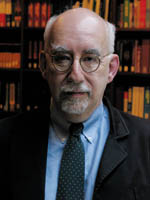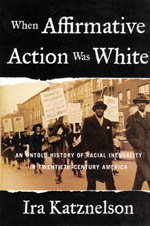|
|
 |
 |
|
|
BOOKSHELFExamining Racial Inequality in AmericaIn the aftermath of Hurricane Katrina, the chaos in New Orleans forced politicians and activists to confront the social inequities that still exist in the United States. “The initial burst of attention to the shocking patterns of inequality this disaster disclosed has passed, and current political realities make such initiatives unlikely in the short term,” says Ira Katznelson ’66, the Ruggles Professor of Political Science and History. “But just when the practical odds seem long, it is especially important that those of us who advocate other outcomes place our principles and proposals on the table, making them part of the national conversation.” An Americanist, Katznelson offers his principles and proposals eloquently in his latest book, When Affirmative Action Was White: An Untold History of Racial Inequality in Twentieth-Century America (W.W. Norton & Co., $25.95). In this revisionist work, he challenges traditional analyses of 20th-century equality policy efforts. 

Ira Katznelson ’66 PHOTO: DAN DEITCH 
Katznelson identifies W.E.B. Du Bois’ 1935 essay “A Negro Nation Within the Nation” as his inspiration. Though written in a year known for progressive New Deal advances such as Social Security and the Wagner Act, the essay contains Du Bois’ stark assertion that “No more critical situation ever faced the Negroes of America than that of today.” Katznelson wanted to explore the contrast between FDR’s campaign of hope and Du Bois’ skepticism. “I found myself dealing with how policy decisions dealing with welfare, work and war excluded or differentially treated African Americans during the New Deal and Fair Deal. That research became chapters of my book that examine social policy, labor law, the segregated military and, perhaps most surprising, the bias built into the structure of the GI Bill.” Examining the neglected history of race relating to public policy, Katznelson contends that the New Deal and subsequent social policies aggravated the gap between white and black Americans rather than leveling the playing field. “Most studies begin when affirmative action formally started in the mid- to late-1960s,” he says. “By contrast, I look back to a moment when the term was not used but when public policy was inflected by white racial advantages. As a historian, I wanted to set this record straight. As a political scientist, I aimed to identify the mechanisms that produced these outcomes. As a citizen, I wished to encourage a return to the wider agenda that President Lyndon Johnson first announced for affirmative action.” 
Born in the Bronx, Katznelson majored in history at the College, leading him to political science. He was motivated by his senior thesis supervisor, Richard Hofstadter, and Juan Linz, “whose Friday morning class in political sociology wonderfully extended well past the lunch hour. I learned how the analytical study of politics could trespass beyond the boundaries of any single discipline.” Katznelson’s years at the College coincided with the civil rights revolution. “These developments forced attention to the nearly all-white composition of my class, and led many of us at the time to ask what might, indeed should, be done to make Columbia a more representative institution,” he notes. After completing his Ph.D. in history at Cambridge University in 1969, Katznelson taught at Columbia for five years before teaching at the University of Chicago and the New School for Social Research. In 1994, he returned to Columbia as a professor; he also served as acting vice president and dean of the faculty for Arts and Sciences in 2003–04. The author of more than a dozen books, Katznelson is president of the American Political Science Association, president of the Social Science History Association and chair of the Russell Sage Foundation Board of Trustees. He is a fellow of the American Academy of Arts and Sciences and the American Philosophical Society. At the moment, however, his focus is spreading the message of When Affirmative Action Was White. Optimistic, Katznelson believes affirmative action has made the United States less racially divided. Now he hopes to see the country pursue a comprehensive plan to reduce inequality and poverty. “By so doing,” he says, ”we can return affirmative action to the original intention of broad-based egalitarian efforts to close the racial gap.” Laura Butchy ’04 Arts
|
|
|||||||||||||||||||||||||||||||||||||||||||||||||||||||